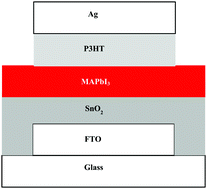Degradation conceptualization of an innovative perovskite solar cell fabricated using SnO2 and P3HT as electron and hole transport layers†
Abstract
The emerging consumer electronics market, indoor and building-integrated photovoltaics, has provided unique commercialization opportunities for perovskite solar cells (PSCs). Despite PSCs' wonderful performance on the laboratory scale, commercialization may not be possible for these new technologies due to their stability and scaling issues. Herein, we will be demonstrating the fabrication and characterization of a PSC of the structure FTO/ETL (∼70 nm)/MAPbI3 (∼300 nm)/P3HT (∼100 nm)/Ag (∼100 nm), using SnO2 or SnO2/TCNE (tetracyanoethylene) as an electron transport layer (ETL) and undoped P3HT (poly(3-hexylthiophene-2,5-diyl)) as a hole transport layer (HTL) with MAPbI3 as an active layer. The fabricated champion device showed an efficiency, fill factor (FF), open-circuit voltage (Voc), and short circuit current density (Jsc) of ∼8%, ∼52%, ∼0.85 V, ∼18.4 mA cm−2 and ∼7.8%, ∼63%, ∼0.87 V, ∼14.2 mA cm−2 on the active area of 4 × 3 mm2 and 5 × 4 mm2 respectively. Moreover, the passivation of the SnO2 layer with TCNE improves the device efficiency and its fabrication success probability. Further, the device degradation behaviour is compared with that of the standard cell of the structure FTO/SnO2 (∼70 nm)/MAPbI3 (∼300 nm)/spiro-OMeTAD (∼100 nm)/Ag (∼100 nm) fabricated under a similar lab condition. The device (with an initial efficiency of ∼5.8%) shows better stability of ∼twenty days with respect to standard cells (with an initial efficiency of ∼5%) of stability of ∼eleven days under ambient conditions (temp ∼30 °C, humidity ∼60%). The T80 lifetime is ∼16 and ∼5 days for the fabricated and standard devices. Moreover, the degradation behaviour of the device is analysed in view of the impact of SnO2, P3HT, and silver electrodes instead of Au and compared with the existing literature on perovskite devices for the device development.



 Please wait while we load your content...
Please wait while we load your content...